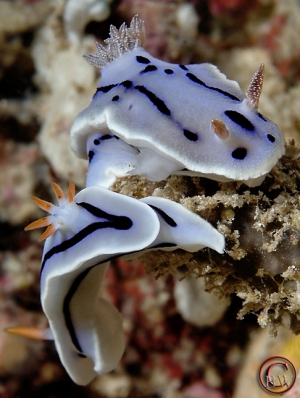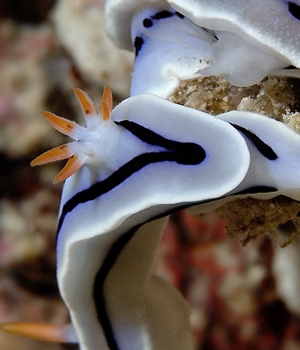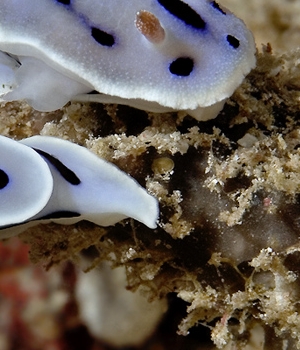Chromodoris willani & C. boucheti- mating?
February 12, 2007
From: Dr Bob Whorton

Unfortunately I mis-timed this mating event of Chromodoris willani and C. (forgotten) by minutes.
Several C. lochi (pink rhinpores & gills) were present in an area of 1 square foot too. 7 in all.
Locality: Hamahera, 14 m, Indonesia, Halmahera Sea, July 2006, coral slope. Length: 3 cm +. Photographer: Bob Whorton.
Bob Whorton
drbob.Whorton@btinternet.com


Dear Bob,
This is a useful message to get just after I posted Peter Southwood's photo of mating? Polycera capensis and P. chilluna [message #19387]. In my comments to that message I may have sounded a bit pedantic in saying that the animals were not actually mating although both had their mating apparatus fully extended. I explained that closely related species, seemed to participate in preliminary mating behaviour, when they were close to each other, but did not complete the mating once contact had been made. It seems their chemical signals are very similar, but once actual contact is made each species can recognise its own kind - even from close relatives. I suspect this photo is an example of that. The one with white-spotted gills is C. willani, as you thought, and the other one looks a bit like C. dianae, but I don't think it is. One form of C. dianae has the upper half of the gills bright yellow, but in that species there are very distinctive white spots [glands?] all over the mantle, like in the photo of C. willani. There is no sign of these spots in this animal. In many ways it looks like C. lochi, but the way the orange colour on the gills stops above the base does not occur in C. lochi.
An interesting possibility is that this is C. boucheti, which has a median black line down the inside of each gill, near the base. If you look at the lower left close-up, there are traces of black at the base of the orange on each gill. Chromodoris boucheti has normally been found only in the western Indian Ocean but we have a record on the Forum from the Maldives Islands [message #11895] and a possible record from Sulawesi [message #5982] so your animal may be the third from the eastern Indian Ocean.
The animals seem to be on a weedy rock, but if you look at the underlying background it is a dark gray sponge which I am pretty sure is Petrosaspongia sp which is the food chosen by C. dianae, C. willani, and C. lochi. We have a record of C. boucheti feeding on a sponge of the same family, so this could be a useful addition to our knowledge of its feeding specificity. If you have other photos of this C. boucheti, showing the gills from a different angle, I would be interested. I suspect the aggregation of similar animals like this is the result of them all preferring this food sponge. For completeness, perhaps you could send a photo of the C. lochi as well, and any photos showing more of the sponge.
Best wishes,
Bill Rudman
Related messages
-
Re: Chromodoris boucheti with a yellow trim from Mayotte
From: Sandrine & Hugues Flodrops, April 1, 2009 -
Re: Chromodoris willani & C. boucheti
From: Bob Whorton, February 13, 2007 -
Re: Chromodoris boucheti with a yellow trim on Pemba
From: Pasquale Pascullo, April 18, 2006 -
Chromodoris boucheti with a yellow trim on Pemba
From: Rob Veelenturf, April 17, 2006 -
Chromodoris boucheti or C. lochi
From: Colin Ogden, November 21, 2005 -
Chromodoris boucheti from the Maldives
From: Fredy Brauchli, January 15, 2004 -
Chromodoris boucheti from Mayotte
From: Marina Poddubetskaia, December 12, 2003 -
Chromodoris boucheti from Pemba
From: Paul Young, November 19, 2002 -
Chromodorid with mutant gills from S.E. Sulawesi
From: Lindsay Warren, April 30, 2002 -
Chromodoris boucheti from Tanzania
From: Bernard Picton , June 28, 2001 -
Chromodoris boucheti from the Maldives
From: Jim Anderson, June 2, 2001 -
Chromodoris boucheti from South Africa
From: Valda Fraser, November 19, 1999
